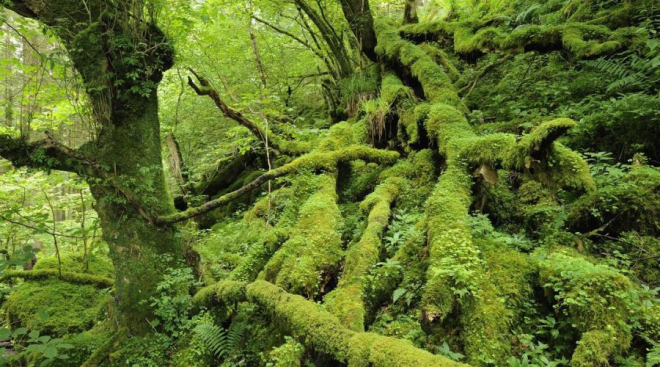Plans to expand Scotland’s rainforest

A new strategic approach for Scotland’s rainforest aims to improve its condition and health so that it can regenerate and expand, whilst providing benefit to communities.
The new approach also aims to work at a landscape scale and strengthen the positive partnership work already in place to restore the rainforest, tackling key threats and targeting public and private funding into projects over the longer-term.
Initially, the plan is to focus on nine key rainforest areas within the rainforest zone which are already undertaking action and engagement and developing co-operative working. New areas within the zone will be brought in for development over time.
Restoration and expansion of Scotland’s rainforest is a key delivery action in Scotland’s Forestry and Biodiversity strategies. During a visit to Knoydart, which is one of the nine initial priority rainforest areas, Rural Affairs Secretary Mairi Gougeon announced the new strategy.
She said:
“Scotland’s rainforest is a treasured natural asset. Restoring and expanding our rainforest will contribute to our nature positive net zero ambitions and conserve this iconic ecosystem for the future, as well as securing jobs and enabling green skills development.
“There is fantastic work already being carried out to restore and expand the rainforest here and by a great number of organisations and individuals working across the whole rainforest zone. Much of this has importantly involved communities, such as the case in Knoydart.
“This new strategic approach published today aims to build on this tremendous work and identify practical steps that the Scottish Government and its partners can take to help rejuvenate Scotland’s rainforest.”
The new strategy has been produced by Scottish Forestry with extensive consultation and input from the Alliance for Scotland’s Rainforest and its partners, who are championing the rainforest and are already undertaking significant work in this area.
Julie Stoneman, project manager with the Alliance for Scotland’s Rainforest, said:
“Scotland’s rainforest holds an immense wealth of threatened wildlife, and it’s great to see it finally starting to receive the attention it deserves.
“Scottish Forestry’s refreshed approach to collaborative, landscape-scale, long term, and community-centric rainforest restoration is key to the future of this internationally important habitat, building on the work of ASR’s partners and rainforest communities.”
Scotland’s rainforest zone stretches along the Atlantic coast of Argyll and the west Highlands, where the climate is wetter and milder. This oceanic climate creates perfect conditions for the rainforest’s rare ferns, bryophytes and lichens.
Key threats to the rainforest include invasive shrubs like rhododendron and deer browsing, both of which prevent the regeneration of native woodland.
In Knoydart, great efforts to control the local population of rhododendron has taken place over the years, along with co-ordinated deer management.
Around 250 hectares of land has been cleared from the invasive shrub, and with deer browsing being managed, the rainforest area continues to thrive. Importantly, these activities generate local employment for the community of Knoydart.
The work to restore and expand Knoydart’s rainforest is carried out by the Knoydart Forest Trust. Lorna Schofield from the Trust said:
"A lot of our work on Knoydart’s rainforest has concentrated on the eradication of invasive rhododendron. This work has spanned 25 years and is ongoing. It has mostly involved the Trust’s staff, backed up by volunteers, local residents and some contractors, and funded through a succession of forestry grants.
“Twenty-five years of community land ownership in Knoydart strongly demonstrates the benefits of long-term community led rainforest regeneration.”
A key thread that runs through the new strategic approach is that developing the rainforest will need to be a be a long-term and sustainable activity, carried out very much in partnership.
John Risby, Scottish Forestry’s Highland and Islands Conservator added:
“The areas of remaining rainforest are beautiful and greatly valued by local people but are facing some serious challenges from fragmentation, overgrazing, invasive rhododendron, deer browsing and pests and diseases.
“By continuing to work co-operatively at a scale which addresses local populations, we can tackle these threats and co-ordinate and channel investment into work which restores and expands this precious habitat.”
Eileen Stuart, Deputy Director of Nature and Climate Change at NatureScot said:
“Only fragments of Scotland’s rainforests remain so it is vital we take a long-term, sustainable approach to restore this unique habitat. We welcome the new approach and look forward to working with partners and communities to drive forward this much needed regeneration.”
Forestry and Land Scotland manages a third of the 30,000 hectares of the rainforest zone and has exceeded its own targets for treating rhododendron and deer control. It has treated 930 hectares of rainforest rhododendron last year and managed a 13% increase in its deer culling in connection with rainforest restoration.
Find the full strategy at Scottish Forestry - Scotland's rainforest





